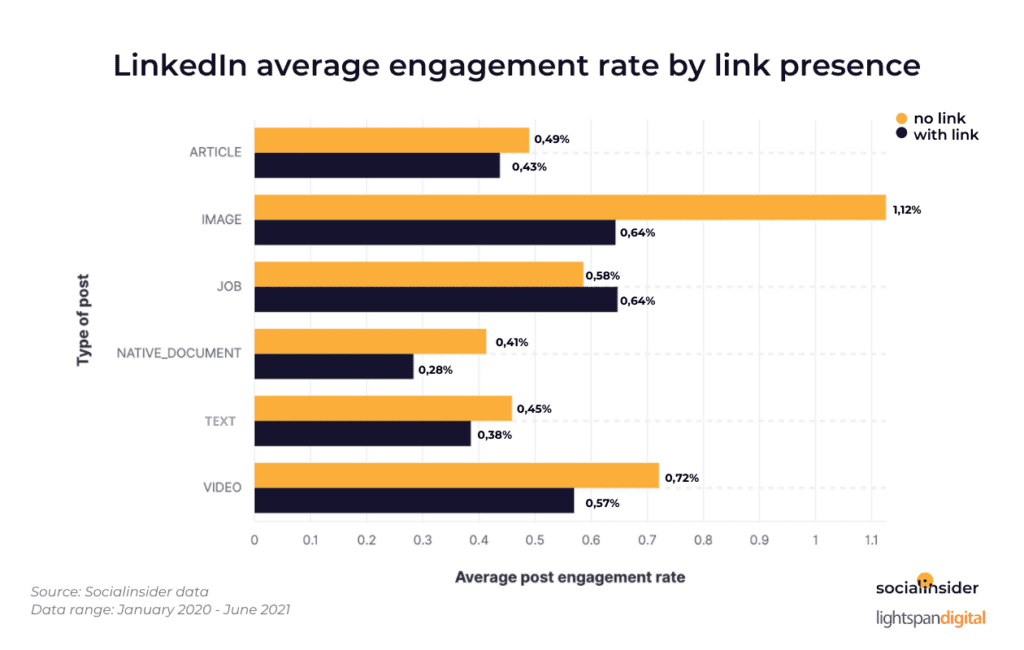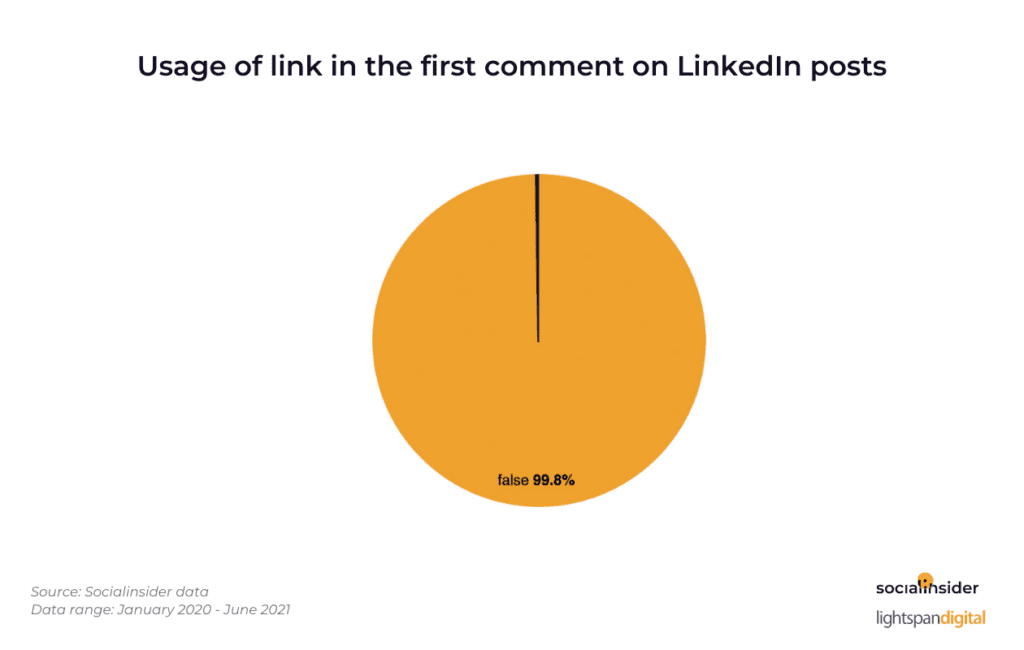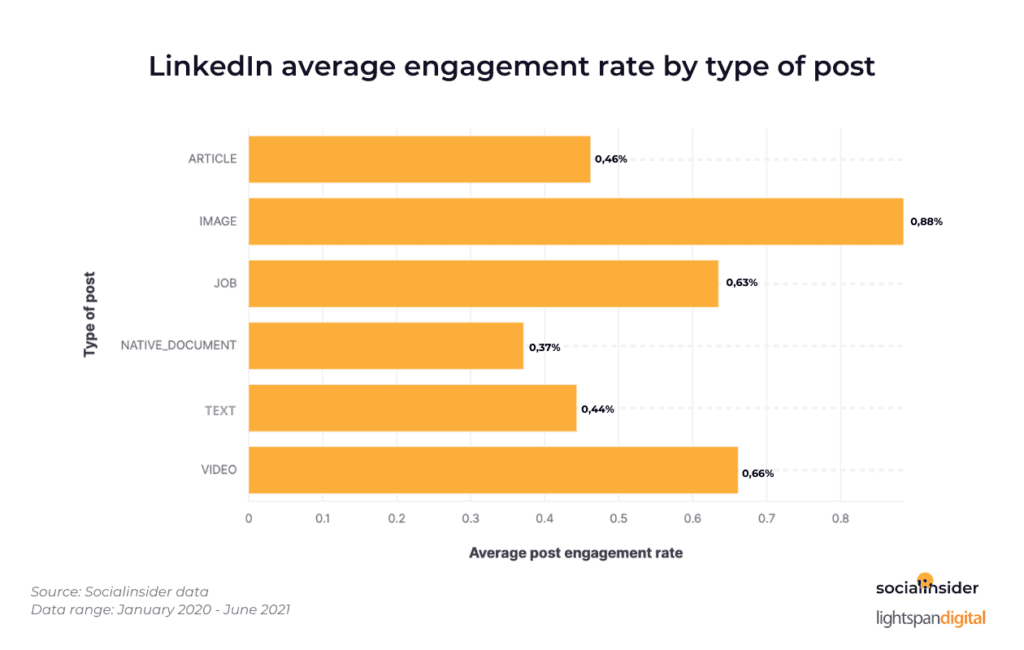One of the biggest debates we hear from LinkedIn fans who are determined to make the social network’s algorithm work in their favor is whether or not to place a link in the post or in the comments. In other words, does LinkedIn’s algorithm favor posts that don’t link off the platform?
The tactic of posting links in the comments instead of creating a post containing a link has become very popular with those who are trying to “work” the LinkedIn algorithm. Are they right? We decided to put it to the test.
Do LinkedIn Posts Without Links Get Better Engagement Than Posts With Links?
Socialinsider, an in-depth social media analytics provider, partnered with us to analyze their trove of data and provide insights. They analyzed 86,504 LinkedIn posts from a total of 883 LinkedIn pages.
What do we mean by a LinkedIn post with a link vs. no link? Typically when we share a resource on LinkedIn, we’ll share a link with our own commentary. But what if we were to share only the commentary, perhaps with an image, and then post the link in the comments?
The hypothesis here is that posts that are not based on a link will perform better than those that share text only or images. And that leads to a preference by many to post the link in the first comment.
If we think about it, it’s in LinkedIn’s interest to keep people on the platform as long as possible. The longer people stay, the more ads they’ll see, which is profitable to LinkedIn. Keeping people on the platform is a key strategy that’s been theorized for most social networks. It also circulates when it comes to Facebook content and might be behind Instagram’s reluctance to enable linking off the platform.
Objectives:
While our original hypothesis was related to the effect of text-based posts, Socialinsider’s volume of data gave us access to additional insight. We looked to:
- Determine how LinkedIn posts perform when placing the link in the posts itself compared with posts without a link
- Determine how LinkedIn posts perform when placing the link in the comments, not in the post itself.
- Find out what type of post performs best overall on LinkedIn
LinkedIn Algorithm Study Key Insights
Posts with no links perform better across all types of posts on LinkedIn.

For example, a single image posted on LinkedIn with no link can get an engagement rate that’s 70% higher than a post with an image and link.
99.8% of companies that use LinkedIn for business don’t usually place links in comments.
To note, based on an analysis of 86,504 LinkedIn posts from a total of 883 LinkedIn pages, brands on LinkedIn usually don’t place links in comments. Most brands are using scheduling tools that limit their options to add links in comments.

The top-performing content on LinkedIn is the image post, with a 0.45% engagement rate per post.
The most common type of business content on LinkedIn is an image with an engagement rate per post of 0.45%. Simply adding just text with no link, video, or link doesn’t increase your chances of getting higher engagement from your content on LinkedIn.

Methodology
Socialinsider tapped into their database to evaluate more than 86,504 LinkedIn posts from a total of 883 LinkedIn pages that had an active presence on LinkedIn between January 2020 and June 2021. During that period, these pages had LinkedIn follower counts between 100 and over 100K.
For the purposes of the study, we define engagement as the measurable interaction on LinkedIn posts, including likes, comments, and shares. The engagement rate is calculated based on the total of these interactions per post, divided by the total follower count.
The LinkedIn data was also analyzed based on page size, defined as the total number of followers that liked the business page.
We used Socialinsider to find out the engagement rates, the type of posts, and the link placement in the post.
Below are the categories of LinkedIn posts analyzed in this case study:
- Article – represents content that links to an article
- Image – represents content that contains images
- Job – represents content that contains jobs
- Native document (PDF) – represents file types (most of the time, these are PDFs) uploaded natively. LinkedIn allows you to create posts that contain documents.
- Text – represents content that does not contain any media
- Video – represents content that contains videos
Conclusion
While it’s impossible to decode social network algorithms, especially since many have AI components built-in, these insights are worth exploring.
While the original hypothesis had to do with links in posts, the finding that image posts get the most engagement is beneficial and easy for you to test out on your audiences. And it may have nothing to do with the algorithm but rather with our visual human nature.
I believe that empathy is the good marketer’s superpower. Powerful content is content that gives the people what they want, how they want it, and where they want it. Algorithms are typically designed to give people what they want so they continue using that social network. If you can figure out how to give YOUR people what they want, you won’t have to worry about the algorithm.
Have you noticed these insights in your data? Let us know in the comments.

Leave a Reply